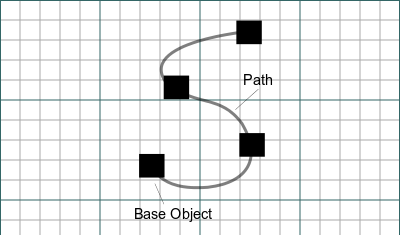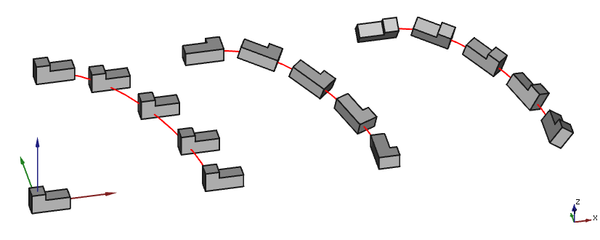Rysunek Roboczy: Szyk po ścieżce
|
|
| Lokalizacja w menu |
|---|
| Modyfikacja → Narzędzia szyku → Szyk po ścieżce |
| Środowisko pracy |
| Rysunek Roboczy, Architektura |
| Domyślny skrót |
| brak |
| Wprowadzono w wersji |
| 0.14 |
| Zobacz także |
| Szyk ortogonalny, Szyk biegunowy, Szyk kołowy, Szyk powiązań po ścieżce, Szyk z punktów, Szyk powiązań w punktach |
Opis
Polecenie Szyk po ścieżce tworzy zwykły szyk z wybranego obiektu przez umieszczenie kopii wzdłuż ścieżki. Zamiast tego użyj polecenia Szyk powiązań po ścieżce, aby utworzyć bardziej wydajny szyk powiązań. Z wyjątkiem typu utworzonych szyków (szyk powiązań lub zwykły szyk), polecenie Szyk powiązań po ścieżce jest identyczne z tym poleceniem.
Oba polecenia mogą być używane na obiektach 2D utworzonych za pomocą środowisk pracy Rysunek Roboczy lub Szkicownik, ale można ich również użyć dla wielu typów obiektów 3D, takich jak te utworzone za pomocą środowisk pracy Część, Projekt Części lub Architektura.
Szyk po ścieżce
Użycie
- Select the object you wish to array.
- Add the path object to the selection. It is also possible to select edges instead. The edges must belong to the same object and they must be connected.
- There are several ways to invoke the command:
- Press the
Draft PathArray button.
- Select the Modification → Array tools →
Path array option from the menu.
- Press the
- The array is created.
- Optionally change the properties of the array in the Property editor.
Alignment
The alignment of the elements in a Draft PathArray depends on the properties of the array and the orientation of the source object. The position of the source object is ignored: for the purpose of the array the x, y and z are set to 0. If the DANEAlign property of the array is set to false the orientation of the array elements is identical to that of the source object. If it is set to true the X axis of the local coordinate system of each element placement is tangent to the path. The Y and Z axes of the local coordinate systems depend on the DANEAlign Mode property of the array. Other array properties involved in the alignment include DANETangent Vector, DANEForce Vertical and DANEVertical Vector.
3 arrays based on the same non-planar path. From left to right: Align is false, Align is true with Align Mode Original and Align is true with Align Mode Frenet
.
Align Mode
Three modes are available:
Original
This mode comes closest to the single DANEAlign Mode available in version 0.18. It relies on a fixed normal vector. If the path is planar this vector is perpendicular to the plane of the path, else a default vector, the positive Z axis, is used. From this normal vector and the local tangent vector (the local X axis) a cross product is calculated. This new vector is used as the local Z axis. The orientation of the local Y axis is determined from the local X and Z axes.
Frenet
This mode uses the local normal vector derived from the path at each element placement. If this vector cannot be determined (for example in the case of a straight segment) a default vector, again the positive Z axis, is used instead. With this vector and the local tangent vector the local coordinate system is determined using the same procedure as in the previous paragraph.
Tangent
This mode is similar to DANEAlign Mode Original but includes the possibility to pre-rotate the source object by specifying a DANETangent Vector.
Force Vertical and Vertical Vector
These properties are only available if DANEAlign Mode is Original or Tangent. If DANEForce Vertical is set to true the local coordinate system is calculated in a different manner. The DANEVertical Vector is used as a fixed normal vector. From this normal vector and the local tangent vector (the local X axis) again a cross product is calculated. But now this vector is used as the local Y axis. The orientation of the local Z axis is determined from the local X and Y axes.
Using these properties can be required if one of the edged of the path is (almost) parallel to the default normal of the path.
Properties
See also: Property editor.
A Draft PathArray object is derived from a Part Feature object and inherits all its properties (with the exception of some View properties that are not inherited by Link arrays). The following properties are additional unless otherwise stated:
Data
Link
The properties in this group are only available for Link arrays. See Std LinkMake for more information.
- DANEScale (
Float) - DANE (Hidden)Scale Vector (
Vector) - DANEScale List (
VectorList) - DANE (Hidden)Visibility List (
BoolList) - DANE (Hidden)Placement List (
PlacementList) - DANE (Hidden)Element List (
LinkList) - DANE (Hidden)_ Link Touched (
Bool) - DANE (Hidden)_ Child Cache (
LinkList) - DANE (Hidden)Colored Elements (
LinkSubHidden) - DANELink Transform (
Bool)
Alignment
- DANEAlign (
Bool): specifies if the elements in the array are aligned along the path or not. If it isfalseall other properties in this group, except DANEExtra Translation, do not apply and are hidden. - DANEAlign Mode (
Enumeration): specifies the align mode, which can beOriginal,FrenetorTangent. - DANEEnd Offset (
Length): specifies the length from the end of the path to the last copy. Must be smaller than the length of the path minus the DANEStart Offset. introduced in version 0.21 - DANEExtra Translation (
VectorDistance): specifies an additional displacement for each element along the path. - DANEForce Vertical (
Bool): specifies whether to override the default normal direction with the value of DANEVertical Vector. Only used if DANEAlign Mode isOriginalorTangent. - DANEStart Offset (
Length): specifies the length from the start of the path to the first copy. Must be smaller than the length of the path. introduced in version 0.21 - DANETangent Vector (
Vector): specifies the alignment vector. Only used if DANEAlign Mode isTangent. - DANEVertical Vector (
Vector): specifies the override for the default normal direction. Only used if DANEVertical Vector istrue.
Objects
- DANEBase (
LinkGlobal): specifies the object to duplicate in the array. - DANECount (
Integer): specifies the number of elements in the array. - DANEExpand Array (
Bool): specifies whether to expand the array in the Tree view to enable the selection of its individual elements. Only available for Link arrays. - DANEPath Object (
LinkGlobal): specifies the object to be used for the path. It must containEdgesin its Part TopoShape. - DANEPath Subelements (
LinkSubListGlobal): specifies a list of edges of the DANEPath Object. If supplied only these edges are used for the path.
View
Link
The properties in this group, with the exception of the inherited property, are only available for Link arrays. See Std LinkMake for more information.
- WIDOKDraw Style (
Enumeration) - WIDOKLine Width (
FloatConstraint) - WIDOKOverride Material (
Bool) - WIDOKPoint Size (
FloatConstraint) - WIDOKSelectable (
Bool): this is an inherited property that appears in the Selection group for other arrays - WIDOKShape Material (
Material)
Base
The properties in this group, with the exception of the inherited property, are only available for Link arrays. See Std LinkMake for more information.
- WIDOK (Hidden)Child View Provider (
PersistentObject) - WIDOK (Hidden)Material List (
MaterialList) - WIDOK (Hidden)Override Color List (
ColorList) - WIDOK (Hidden)Override Material List (
BoolList) - WIDOK (Hidden)Proxy (
PythonObject): this is an inherited property.
Display Options
The properties in this group are inherited properties. See Part Feature for more information.
- WIDOKBounding Box (
Bool): this property is not inherited by Link arrays. - WIDOKDisplay Mode (
Enumeration): for Link arrays it can beLinkorChildView. For other arrays it can be:Flat Lines,Shaded,WireframeorPoints - WIDOKShow In Tree (
Bool) - WIDOKVisibility (
Bool)
Draft
- WIDOKPattern (
Enumeration): not used. - WIDOKPattern Size (
Float): not used.
Object style
The properties in this group are not inherited by Link arrays.
Scripting
See also: Autogenerated API documentation and FreeCAD Scripting Basics.
To create a path array use the make_path_array method (introduced in version 0.19) of the Draft module. This method replaces the deprecated makePathArray method.
path_array = make_path_array(base_object, path_object,
count=4, extra=App.Vector(0, 0, 0), subelements=None,
align=False, align_mode="Original", tan_vector=App.Vector(1, 0, 0),
force_vertical=False, vertical_vector=App.Vector(0, 0, 1),
use_link=True)
base_objectis the object to be arrayed. It can also be theLabel(string) of an object in the current document.path_objectis the path object. It can also be theLabel(string) of an object in the current document.countis the number of elements in the array.extrais a vector that displaces each element.subelementsis a list of edges ofpath_object, for example["Edge1", "Edge2"]. If supplied only these edges are used for the path.- If
alignisTruethe elements are aligned along the path depending on the value ofalign_mode, which can be"Original","Frenet"or"Tangent". tan_vectoris a unit vector that defines the local tangent direction of the elements along the path. It is used whenalign_modeis"Tangent".- If
force_verticalisTruevertical_vectoris used for the local Z direction of the elements along the path. It is used whenalign_modeis"Original"or"Tangent". - If
use_linkisTruethe created elements are App Links instead of regular copies. path_arrayis returned with the created array object.
Przykład:
import FreeCAD as App
import Draft
doc = App.newDocument()
p1 = App.Vector(500, -1000, 0)
p2 = App.Vector(1500, 1000, 0)
p3 = App.Vector(3000, 500, 0)
p4 = App.Vector(4500, 100, 0)
spline = Draft.make_bspline([p1, p2, p3, p4])
obj = Draft.make_polygon(3, 500)
path_array = Draft.make_path_array(obj, spline, 6)
doc.recompute()
wire = Draft.make_wire([p1, -p2, -p3, -p4])
path_array2 = Draft.make_path_array(obj, wire, count=3, extra=App.Vector(0, -500, 0), subelements=["Edge2", "Edge3"], align=True, force_vertical=True)
doc.recompute()
- Kreślenie: Linia, Polilinia, Zaokrąglenie, Łuk, Łuk przez 3 punkty, Okrąg, Elipsa, Wielokąt foremny, Krzywa złożona, Krzywa Bezier'a, Punkt, Łącznik ścian, Kształt z tekstu, Kreskowanie, Prostokąt
- Adnotacje: Adnotacja wieloliniowa, Wymiarowanie, Etykieta, Edytor stylów adnotacji, Widżet skali anotacji
- Modyfikacja: Przesuń, Obróć, Skala, Odbicie lustrzane, Odsunięcie, Przytnij, Rozciągnij, Klonuj, Szyk, Szyk biegunowy, Szyk kołowy, Szyk po ścieżce, Szyk powiązań po ścieżce, Szyk z punktów, Szyk powiązań w punktach, Edycja, Podświetl element podrzędny, Połącz, Rozdziel, Ulepsz kształt, Rozbij obiekt na elementy, Polilinia na krzywą złożoną, Rysunek Roboczy do szkicu, Nachylenie, Obróć wymiar, Widok 2D kształtu
- Tacka narzędziowa: Wybór płaszczyzny, Ustaw styl, Przełącz tryb konstrukcyjny, Grupowanie automatyczne
- Przyciąganie: Przełącz przyciąganie, Przyciągnij do punktu końcowego, Przyciągnij do punktu środkowego, Przyciągnij do środka, Przyciągnij do kąta, Przyciąganie do punktu przecięcia, Przyciągnij prostopadle, Rozszerz, Przyciągnij równolegle, Przyciągnij specjalnie, Przyciąganie do najbliższego, Przyciągnij ortogonalnie, Przyciągnij do siatki, Przyciągnij do płaszczyzny roboczej, Przyciągnij do wymiaru, Pokaż / ukryj siatkę
- Różności: Zastosuj bieżący styl, Warstwa, Zarządzaj warstwami, Dodaj grupę o nazwie, Dodaj do grupy, Wybierz grupę, Dodaj do grupy konstrukcyjnej, Przełącz tryb wyświetlania, Pośrednia płaszczyzna robocza, Ulecz, Przełącz tryb kontynuacji, Pokaż przybornik przyciągania
- Dodatkowe:: Wiązania, Wypełnienie wzorem, Preferencje, Ustawienia Importu i Eksportu, DXF/DWG, SVG, OCA, DAT
- Menu podręczne:
- Kontener warstwy: Połącz duplikaty warstw, Dodaj warstwę
- Warstwa: Aktywuj warstwę, Zaznacz zawartość warstwy
- Pośrednia płaszczyzna robocza: Zapisz ujęcie widoku, Zapisz stan obiektów
- Jak zacząć
- Instalacja: Pobieranie programu, Windows, Linux, Mac, Dodatkowych komponentów, Docker, AppImage, Ubuntu Snap
- Podstawy: Informacje na temat FreeCAD, Interfejs użytkownika, Profil nawigacji myszką, Metody wyboru, Nazwa obiektu, Edytor ustawień, Środowiska pracy, Struktura dokumentu, Właściwości, Pomóż w rozwoju FreeCAD, Dotacje
- Pomoc: Poradniki, Wideo poradniki
- Środowiska pracy: Strona Startowa, Architektura, Assembly, CAM, Rysunek Roboczy, MES, Inspekcja, Siatka, OpenSCAD, Część, Projekt Części, Punkty, Inżynieria Wsteczna, Robot, Szkicownik, Arkusz Kalkulacyjny, Start, Powierzchnia 3D, Rysunek Techniczny, Test Framework, Web

